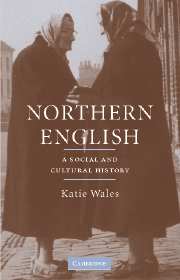Book contents
- Frontmatter
- Contents
- List of illustrations
- Preface
- List of abbreviations and symbols
- 1 ‘The North–South divide’
- 2 The origins of Northern English
- 3 Northern English and the rise of ‘Standard English’
- 4 Northern English after the Industrial Revolution (1750–1950)
- 5 Northern English present and future
- References
- Index of Northern English features
- General index
2 - The origins of Northern English
Published online by Cambridge University Press: 22 September 2009
- Frontmatter
- Contents
- List of illustrations
- Preface
- List of abbreviations and symbols
- 1 ‘The North–South divide’
- 2 The origins of Northern English
- 3 Northern English and the rise of ‘Standard English’
- 4 Northern English after the Industrial Revolution (1750–1950)
- 5 Northern English present and future
- References
- Index of Northern English features
- General index
Summary
Northern dialects and ‘boundaries’ in the Old English period
Many of the present-day images of Northern English and the North discussed in the first chapter are deeply rooted in history. Much of the North, especially the North-west and Scotland also, has remained ‘alien’ and inaccessible till modern times. Indeed, until the advent of the railways the easiest route to Scotland via the North-west was by boat from Fleetwood in Lancashire to Ardrossan on the Clyde coast (Hannavy 2003: 58). Lancashire until the eighteenth century remained hemmed in between the Mersey marshes, the Pennines and the Lake District, although accessible to Ireland. According to a seventeenth-century poem Iter Lancastrense the sparse roads were ‘gulphes of dust and mire’ (cited Langton 1998: 83) since the main roads north and south across Britain lay east of the Pennines. There was Ermine Street, for example, built by the Romans, part of the present-day Great North Road or A1, and implied on an early map of Britain by Matthew Paris of St Albans (c.1250). But even as late as 1740 there was no turnpike north of Grantham (see further chapter 3). The Norman bishop Geoffrey of Monmouth in his History of the Kings of Britain said of the land across the Humber that, for the invading Saxons, it was ‘a frightful land to live in, more or less uninhabited’, and that it therefore offered a safe hiding-place for foreigners (cited Jewell 1994: 187).
- Type
- Chapter
- Information
- Northern EnglishA Social and Cultural History, pp. 32 - 63Publisher: Cambridge University PressPrint publication year: 2006

